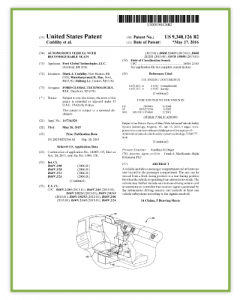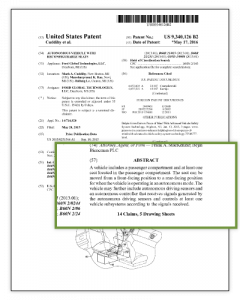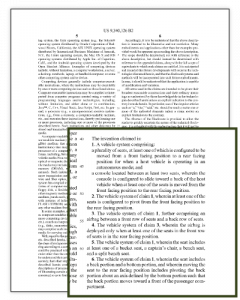What Information is included in a Patent?
And Does it Apply to Stakeholders of a Patent Lifecycle
Patents are composed of several different parts, each of which serves a particular purpose in securing the rights of an invention. Each component can provide information to the various stakeholders in the life of a patent. These stakeholders range from inventors, patent owners, licensees and patent examiners.
Whether you are seeking to understand your own patent rights, researching if your idea could potentially infringe on others, or simply wanting to know more about the patent process, this guide will provide you the basics in breaking down a patent.
Stakeholders of a Patent:
A patent has several stakeholders, who are impacted in different ways by the existence of a patent. The most direct stakeholders are the inventors who conceptualized the invention that is now patented. The inventor’s rights to the patent vary depending on ownership, further explained below.
The next most direct stakeholders are the patent owner and the patent examiners.
The patent owner may be the inventor, but may also be someone to whom the inventor has sold or assigned the patent rights. The patent owner is given exclusive rights to the invention, meaning they can prevent others from making, using, or selling the invention without their permission. This period of exclusivity lasts for 20 years from the date the patent application was filed.
The patent examiners are government employees who are responsible for ensuring that all patent applications meet the requirements for patent rights to be granted. Patent examiners play a core role in the patent process, as they are responsible for thoroughly reviewing patent applications and their many components.
A lesser known stakeholder is the licensee. A licensee is one that uses the claimed subject matter in a patent with permission of the patent owner. This is typically arranged in a licensing agreement in which the licensee pays the patent owner for the rights to use the product or process claimed in the patent.
There are also indirect stakeholders, who are not directly impacted by the existence of a patent but may be affected by it. These include product developers and engineers, who may need to understand the technology of the patent. They also include businesses who may want to license the invention, consumers who may benefit from the invention, and competitors who may be prevented from making or selling a similar invention.
Sections of a Patent:
Each patent is required to provide certain information to comply with the various rules for patents. This information is organized into a series of sections, described below.
- The front page or cover page, which includes a variety of identification information such as the type of patent document, patent number, applicants, inventors and assignees of the patent, dates of the patent and patent application filing, and the patent attorney or firm;
- The abstract, which provides a brief summary of the disclosure as contained in the above-mentioned components;
- The drawings, which show the invention in visual form;
- The specification, which describes the invention in detail of the field, background, summary, and descriptions of the technology and drawings; and
- The claims, which define the invention’s scope and protections.
Let’s take a closer look at each section and the stakeholders that can benefit from the information provided.
Front Page
 Who it’s relevant to:
Who it’s relevant to:
The front page includes identification information that is useful to all stakeholders. Inventors can use the front page to identify who owns the patent and when the patent expires. Patent owners can use the front page to seek basic administrative information and a broad overview of the patent. Patent examiners can use the front page to understand the technology of the invention, and to determine if the invention is novel and non-obvious. Businesses can use the front page to find technologies that they may want to license, and competitors can use the front page to find technologies that are similar to their own.
What it contains:
- type of patent document – the type of patent document can inform stakeholders of whether the patent is a design, utility, or plant patent.
- patent number – the patent number can be used by stakeholders to identify the specific patent document.
- applicants, inventors, and assignees – the applicants, inventors, and assignees can be used to identify the individuals who created the invention or currently hold the rights to the invention.
What is the difference between applicants, inventors, and assignees?
The applicant is the individual who files the patent application. The inventor is the individual who creates the invention. The assignee is the individual or entity to whom the inventor has transferred or assigned the patent rights.
- date of the patent – the patent date can inform stakeholders of when the patent was filed and when the protected rights will expire.
- patent attorney or firm – the patent attorney or firm can provide information about who is representing the patent owner and can be used as a resource for further information about the patent.
Drawings
 Who it’s relevant to:
Who it’s relevant to:
Quality drawings can affect many stakeholders of a patent. Inventors can use drawings to show the structure of their invention, and to explain how it works. Patent examiners can use drawings to understand the invention, and to determine if the invention is novel and non-obvious. Businesses can use drawings to find technologies that they may want to license, and competitors can use drawings to find technologies that are similar to their own.
What it contains:
The drawings should accurately represent the invention, and should be clear and concise. The drawings should include any views necessary to understand the invention, including perspective, cross-sectional, exploded, and perspective exploded views. The drawings should also include any accompanying text, such as labels and notes.
Patent Abstract
 Who it’s relevant to
Who it’s relevant to
The patent abstract is a brief summary of the disclosure and is useful to most stakeholders. Inventors can use it to understand the invention, and to ensure that all the information in the patent application is accurately represented. Patent owners can use it to check for potential infringers, send cease and desist letters, or seek licensing opportunities. Patent examiners can use it to understand the technology of the invention, and to determine if the invention is novel and non-obvious. Businesses can use it to find technologies that they may want to license, and competitors can use it to find technologies that are similar to their own.
What it contains:
The abstract should include a brief summary of the disclosure as contained in the specification and claims. It should be written in a way that is understandable to someone who is not an expert in the field, and should not be more than 150 words.
Claims of an Invention
 Who it’s relevant to:
Who it’s relevant to:
The claims of an invention are particularly important to inventors, patent owners, patent examiners, and licensees. Inventors can use the claims to understand the boundaries of their invention, and to ensure that their patent application is complete. Patent owners can use the claims to identify potential infringers, and to determine the scope of their patent. Licensees can use the claims to see if they are actually using the claimed product or process. Patent examiners can use the claims to understand the invention, and to determine if the invention is novel and non-obvious.
What it contains:
Patent claims are arguably one of the most important aspects of a patent.
A patent claim is a statement that defines the scope of protection for the invention. Patent claims are written in a specific format, and should be clear and concise. The claims should accurately describe the invention, and should not be longer than 20 words.
Assistance with Your Patent Needs
Regardless of where you are within the innovation ecosystem, our team of intellectual property attorneys can assist you with your patent needs. We have experience with all aspects of patents, from filing a patent application to enforcing a patent against infringers. We also offer a wide range of services, such as patent searches, portfolio valuation, and licensing agreements. Contact us today to learn more about how we can help you.
Robert Wiesenberg
Intellectual Property Attorney
rweisenberg@founderslegal.com
Rob is a patent, trademark, and technology associate at Founders Legal. Rob performs patent prosecution, trademarks, and outside general counsel assistance.
Prior to law school, Rob conducted high energy nuclear physics research for Georgia State University and created, coded, and appropriated specialized software for local political campaigns. While in law school, Rob participated in patent prosecution, corporate governance, and trademark law clerking at Founders Legal.




